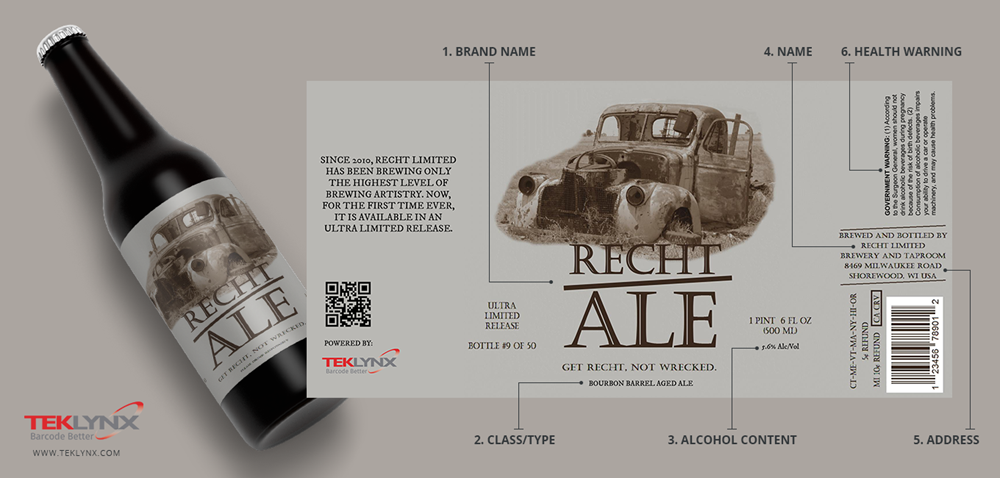En iyi web sitesi deneyimi için lütfen konumunuzu ve dilinizi seçin

While shopping at your grocery store, you’ll notice almost all food and drink products have a nutrition label that lists ingredients, calories, and serving size. But when browsing the alcohol section, you might be surprised to see very few nutrition labels. While the Food & Drug Administration (FDA) regulates all food and beverages in the United States and requires nutrition labels, there is one exception – alcohol.
This blog will help break down the labeling regulations for alcoholic beverages, common labeling errors for alcohol, and how to overcome them.
The Alcohol and Tobacco Tax and Trade Bureau (TTB) is responsible for creating and regulating the guidelines for alcoholic labels in the United States, so when the FDA made nutrition labels required in 1990, alcoholic labels were excluded.
Your favorite candy bar or sparkling water contains a standard nutrition label that requires serving size and facts, calories, carbohydrates, protein, fat, ingredients, and common allergens, but the TTB has not made this information mandatory on alcohol labels. So, when you see an alcoholic beverage containing this information, it is completely voluntary, which is why Anheuser-Busch made headlines in 2019 when they become the first major beer company to include serving facts and ingredients on their Bud Light beer.
So, if the standard nutrition facts and ingredients aren’t required on an alcoholic beverage label, what is? Let’s break it down.
The TTB has different labeling requirements depending on the type of alcohol. To see the full list of requirements for the alcohol beverage you are producing, or to find more resources, visit the TTB labeling resource page. Below are the common requirements for beer, distilled spirits, and wine labels.

A typo on an alcoholic beverage label might seem like a small error, but there is a hefty price to pay – disruption in production, denied label applications, and even fines that are thousands of dollars.
Alcohol beverage labels are typically artwork-heavy to catch consumer attention. On top of the large number of graphics, there also needs to be enough space for the information that’s required by the TTB. If an image gets compressed, small font on the label becomes hard to read, making your labels non-compliant.
Ensure your labels have the correct, high-resolution images by pulling your graphics directly from your database, ERP system, or artwork management platform. Also, note that your labels need to be water resistant, so it’s important to find the correct label stock that does not smudge your label text or artwork and cannot easily be damaged. If you need label stock or label printers, get in touch with us and we can put you in contact with one of our value-added resellers.
Before selling your alcoholic product, you must submit your label to the TTB for a Certificate of Label Approval (COLA). If any information required by the TTB is missing from your label, or the information on your label doesn’t match your submitted application for a COLA, you will be denied or even worse – fined. According to the Alcoholic Beverage Labeling Act (ABLA), the penalty for not having the proper health warning statement on your label is up to $22,979 USD per offense.
The best way to avoid labeling errors is to have as few manual processes as possible. Instead of manually entering data onto each separate label which is time-consuming and prone to mistakes, set up smart label templates that are composed of variable fields in CODESOFT label design software. When your label pulls data directly from your business system, you don’t have to worry about typing in incorrect information.
To eliminate the possibility of entering the health warning statement incorrectly, simply save the text as a .txt file or as a new field in your database. Now, when you open your label template, the correct health warning statement is already there without any work. What happens if the TTB creates a new regulation that changes the wording of the health statement? Easy fix! Go to the text file or location where you saved the statement, edit it, and all your labels will update automatically. Visit our Support Center and search “How to import data from a text (.txt) file” to see the full tutorial.
Since each alcohol beverage label must be approved by the TTB before the product goes to market, any change to your label needs to be submitted for reapproval. A common error that alcohol beverage manufacturers and producers make is revising their label without submitting it for reapproval. If someone goes into the label and changes the artwork, there is a chance the label is no longer approved by the TTB, which can cause compliance issues.
The best way to protect your labels from unauthorized changes is to enact a label approval process. With LABEL ARCHIVE security and traceability software, you have the ability to set up a customized approval process where a label isn’t considered final until it has been approved. User permissions within LABEL ARCHIVE ensure only authorized users can edit a label, so no accidental changes are made.
The United States is continuing to see a rise in the popularity of microbreweries, meaning many new small businesses are emerging. Here are a few tips to make alcohol beverage labeling for your small business, distillery, winery, or brewery a success.
If you are just getting into the alcoholic beverage business or are already established, but need a better labeling solution, request a consult to see which TEKLYNX product is best for you.
Nick Recht is the Sales Manager for the Americas region at TEKLYNX RFID and barcode label solution provider. He leverages his passion for using technology to add value to businesses and his 14 years of AIDC experience to help organizations of all sizes barcode better. When he is not working, he is driving one of his daughters to a practice of some sort or doing a project around the house.
When it comes to the food and beverage industry, it is incredibly important to have the best label software in place to ensure efficiency, stability, and peace of mind throughout the supply chain.
READ MORE
You’ve created a great product and made it to store shelves! Your hard work is starting to pay off, and now it’s time to make sure you’re setting your product up for the commercial success it deserves. Designing an attractive and professional product label is the best way to make sure your product stands out, and images are a great way to do just that.
READ MORE
This blog will cover barcode labeling tips for small businesses to implement no matter where they’re at with their labeling process – handwriting labels, purchasing pre-printed labels from a vendor, or using software to design and print labels.
READ MORE© Telif hakkı 2024 TEKLYNX CORPORATION SAS. Tüm Hakları Saklıdır.
What do you think? Leave us a comment.
Comments will be reviewed and are subject to TEKLYNX’ comment policy. Your email address will not be published publicly.